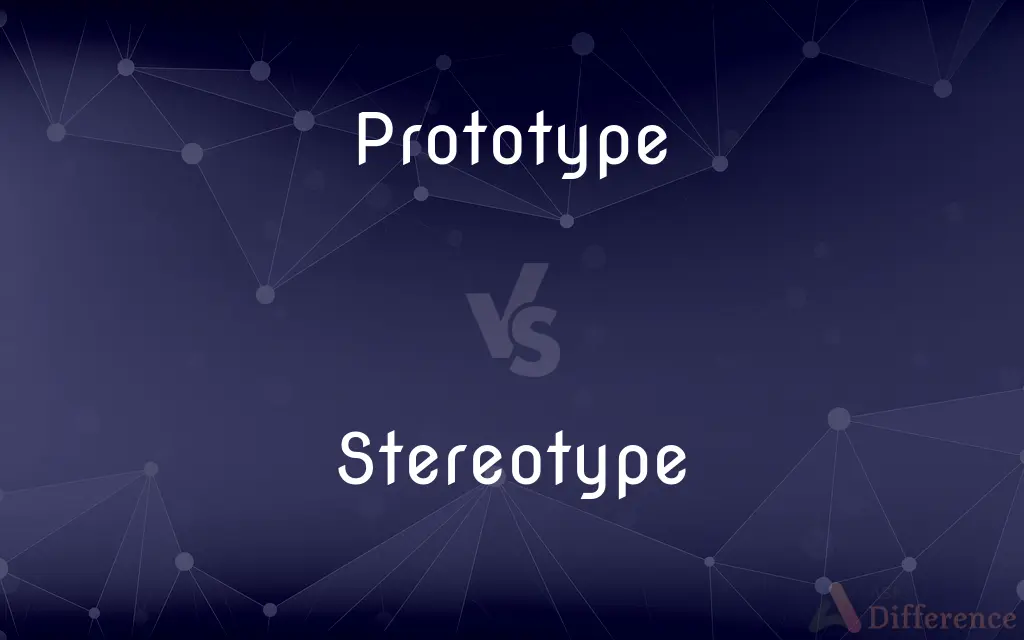Prototype vs. Stereotype — What's the Difference?
By Urooj Arif & Maham Liaqat — Updated on February 29, 2024
A prototype is an original model or preliminary version of a product used to test and refine design concepts, while a stereotype is a widely held but oversimplified and generalized belief about a particular group of people or type of person.

Difference Between Prototype and Stereotype
Table of Contents
ADVERTISEMENT
Key Differences
A prototype serves as the foundational model from which further iterations and final products are developed, crucial in the design and engineering process. In contrast, a stereotype is a cognitive construct that simplifies social perception by categorizing individuals based on perceived group characteristics, often leading to misconceptions.
Prototypes are created to explore the feasibility, functionality, and appearance of a new design, allowing for adjustments before mass production. Stereotypes, although not purposefully created, are used (often subconsciously) to quickly make sense of social interactions, but they can result in prejudice and discrimination.
The development of a prototype is a deliberate, iterative process involving testing and refinement based on feedback. The formation of stereotypes is a social process, influenced by cultural, educational, and media narratives, and can be passed down or reinforced through generations.
Prototypes have a practical impact, facilitating innovation and improvements in technology and design. Stereotypes, however, have social implications, affecting perceptions and behaviors towards others, potentially leading to social divisions and inequalities.
Comparison Chart
Definition
An original model or early version of a product for testing and refinement.
An oversimplified, generalized belief about a group of people.
ADVERTISEMENT
Purpose
To test and refine design concepts before final production.
To categorize individuals quickly based on group characteristics.
Development
A deliberate, iterative process involving feedback and adjustments.
A social process influenced by culture, media, and education.
Impact
Facilitates innovation and improvements in products or systems.
Can lead to prejudice, discrimination, and social inequality.
Nature
Concrete and physical (or digital in software development).
Abstract and cognitive, based on perception and belief.
Flexibility
Designed to be modified and improved based on testing.
Often rigid and resistant to change without conscious effort.
Use in Context
Used in design, engineering, and product development.
Used in social perception and interaction.
Outcome
Leads to the creation of a final, optimized product.
Influences social attitudes and can perpetuate biases.
Compare with Definitions
Prototype
An initial model of a product to test its feasibility.
The engineering team built a prototype of the new drone to evaluate its design.
Stereotype
Affects social interactions and attitudes.
Stereotypes can hinder the formation of genuine, unbiased interpersonal relationships.
Prototype
A preliminary version used to refine concepts.
Designers created a prototype of the app to test user interface ideas.
Stereotype
Can lead to unfair assumptions and prejudice.
Stereotypes about gender roles often limit individuals' personal and professional opportunities.
Prototype
Often physical, but can be digital in software development.
The software prototype allowed early testing of the platform's functionality.
Stereotype
A generalized belief about a group's characteristics.
The stereotype that all teenagers are reckless can influence how to treat them.
Prototype
Subject to revisions based on testing outcomes.
Feedback on the prototype led to significant improvements in the product's ergonomics.
Stereotype
Resistant to change without conscious effort.
Challenging stereotypes requires actively questioning and revising one's beliefs.
Prototype
A critical step in the design process.
Prototyping is essential for identifying potential issues early in the design phase.
Stereotype
Formed by social, cultural, and media influences.
Media portrayals contribute to the stereotype of the successful businessperson.
Prototype
A prototype is an early sample, model, or release of a product built to test a concept or process. It is a term used in a variety of contexts, including semantics, design, electronics, and software programming.
Stereotype
In social psychology, a stereotype is a generalized belief about a particular category of people. It is an expectation that people might have about every person of a particular group.
Prototype
An original type, form, or instance serving as a basis or standard
"The abolitionists were the prototype of modern citizen activism" (Adam Hochschild).
Stereotype
A relief printing plate cast in a mould made from composed type or an original plate.
Prototype
An original, full-scale, and usually working model of a new product or new version of an existing product.
Stereotype
One that is regarded as embodying or conforming to a set image or type.
Prototype
A typical example of a class or category
"He fit the prototype of the artist as social misfit and compulsive contrarian" (Stephen Holden).
Stereotype
To prepare for printing in stereotype; to make the stereotype plates of; as, to stereotype the Bible.
Prototype
A standard or typical example;
He is the prototype of good breeding
He provided America with an image of the good father
Stereotype
A conventional or formulaic conception or image;
Regional stereotypes have been part of America since its founding
Stereotype
Treat or classify according to a mental stereotype;
I was stereotyped as a lazy Southern European
Common Curiosities
Why are stereotypes considered harmful?
Stereotypes can lead to prejudice, discrimination, and social inequalities by promoting unfounded and generalized beliefs about groups of people.
How are stereotypes formed?
Stereotypes are formed through social processes, influenced by culture, media, and personal experiences, and can be reinforced by communities and institutions.
Can prototypes be digital?
Yes, prototypes can be both physical and digital, especially in software and web development, where they are used to test functionality and user experience.
What is the main difference between a prototype and a stereotype?
A prototype is a preliminary model used in design and development processes, while a stereotype is an oversimplified belief about a group of people.
How do prototypes benefit product development?
Prototypes allow for testing, refinement, and validation of design concepts, reducing risks and costs by identifying issues early.
Is it possible to change stereotypes?
While challenging, stereotypes can be changed through education, personal experiences, and exposure to more diverse perspectives and information.
Can the concept of a prototype apply to services?
Yes, service prototyping is a method used to visualize and test service processes, customer interactions, and touchpoints before full-scale implementation.
What role does feedback play in prototyping?
Feedback is crucial in the prototyping process, as it provides insights for improvements and refinements to meet the users' needs and expectations more effectively.
How can one challenge and overcome stereotypes?
Challenging stereotypes involves questioning generalized beliefs, seeking accurate information, and fostering empathy through understanding diverse perspectives.
Can a prototype evolve into the final product?
Yes, prototypes are often refined through several iterations based on testing and feedback, eventually evolving into the final product.
Why do stereotypes persist in society?
Stereotypes persist due to cultural reinforcement, lack of exposure to diversity, and the human tendency to simplify complex social information.
How do prototypes and stereotypes differ in flexibility?
Prototypes are designed to be flexible and subject to change, whereas stereotypes are often rigid and resistant to change without deliberate effort.
How do stereotypes affect interpersonal relationships?
Stereotypes can negatively impact relationships by leading to misunderstandings, biases, and unfair treatment based on generalized beliefs.
What impact do prototypes have on innovation?
Prototypes are critical for innovation, allowing designers and engineers to explore new ideas, test boundaries, and refine solutions before market release.
What strategies can organizations use to counteract stereotypes?
Organizations can promote diversity and inclusion training, encourage open dialogue, and represent diverse groups fairly in media and communications to counteract stereotypes.
Share Your Discovery

Previous Comparison
Sammie vs. Sammy
Next Comparison
Rue vs. StreetAuthor Spotlight
Written by
Urooj ArifUrooj is a skilled content writer at Ask Difference, known for her exceptional ability to simplify complex topics into engaging and informative content. With a passion for research and a flair for clear, concise writing, she consistently delivers articles that resonate with our diverse audience.
Co-written by
Maham Liaqat















































